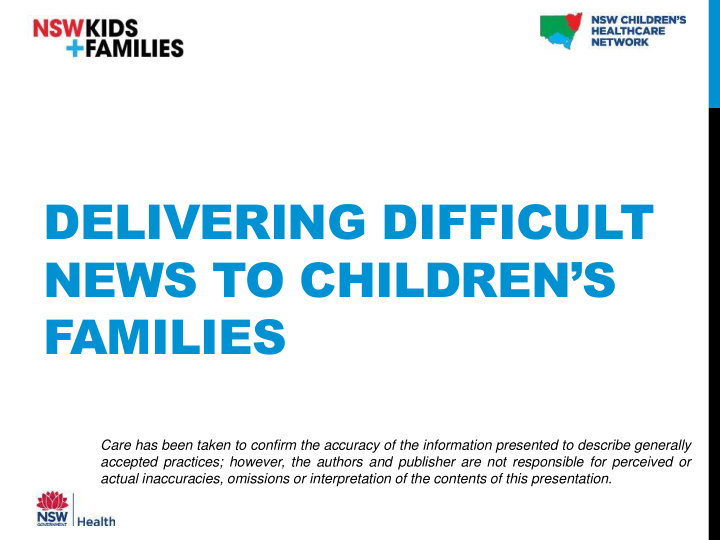



DELIVERING DIFFICULT NEWS TO CHILDREN’S FAMILIES Care has been taken to confirm the accuracy of the information presented to describe generally accepted practices; however, the authors and publisher are not responsible for perceived or actual inaccuracies, omissions or interpretation of the contents of this presentation.
LEARNING OBJECTIVES 1. Identify the communication skills required in effectively delivering difficult news. Identify the key aspects of participant’s own communication 2. style. 3. Demonstrate the communication skills required in effectively delivering difficult news.
KEY SKILLS IN DELIVERING DIFFICULT NEWS i. Delivers difficult news ii. Appropriately manages emotional fallout iii. Uses therapeutic communication style
i. DELIVERS DIFFICULT NEWS • Delivers specific feedback objectively, constructively and in plain language. • Delivers bad news appropriately. • Asks direct questions – simple, open, non-judgemental. • Listens effectively.
ASKING QUESTIONS ( STARR, 2008 ) What does a good question sound like? It’s simple – complex questions confuse people. It has a purpose – gathers information. It should be influencing without being controlling.
LEVELS OF LISTENING (STAR, 2008) If it looks like I’m listening, I’m not Cosmetic listening really. I’m kind of someplace else. I’m engaged in the conversation, Conversational listening listening, talking, thinking. I’m very focused on what you’re Active listening saying, recording facts, paying attention. I’m more focused on you than me. Deep listening
ii. APPROPRIATELY MANAGES EMOTIONAL FALLOUT • Not personal. • Remains calm. • Not escalating. • Utilises team members. • Maintains personal and participant safety.
iii. USES THERAPEUTIC COMMUNICATION STYLE • Open body language. • Same physical level. • Presence (eye contact). • Clarifies as needed (reframing). • Team members support each other. • Team leader summarises and closes loop.
DELIVERING DIFFICULT NEWS IN A TEAM SITUATION
REVIEW LEARNING OBJECTIVES 1. Identify the communication skills required in effectively delivering difficult news. Identify the key aspects of participant’s own communication 2. style. 3. Demonstrate the communication skills required in effectively delivering difficult news.
Recommend
More recommend